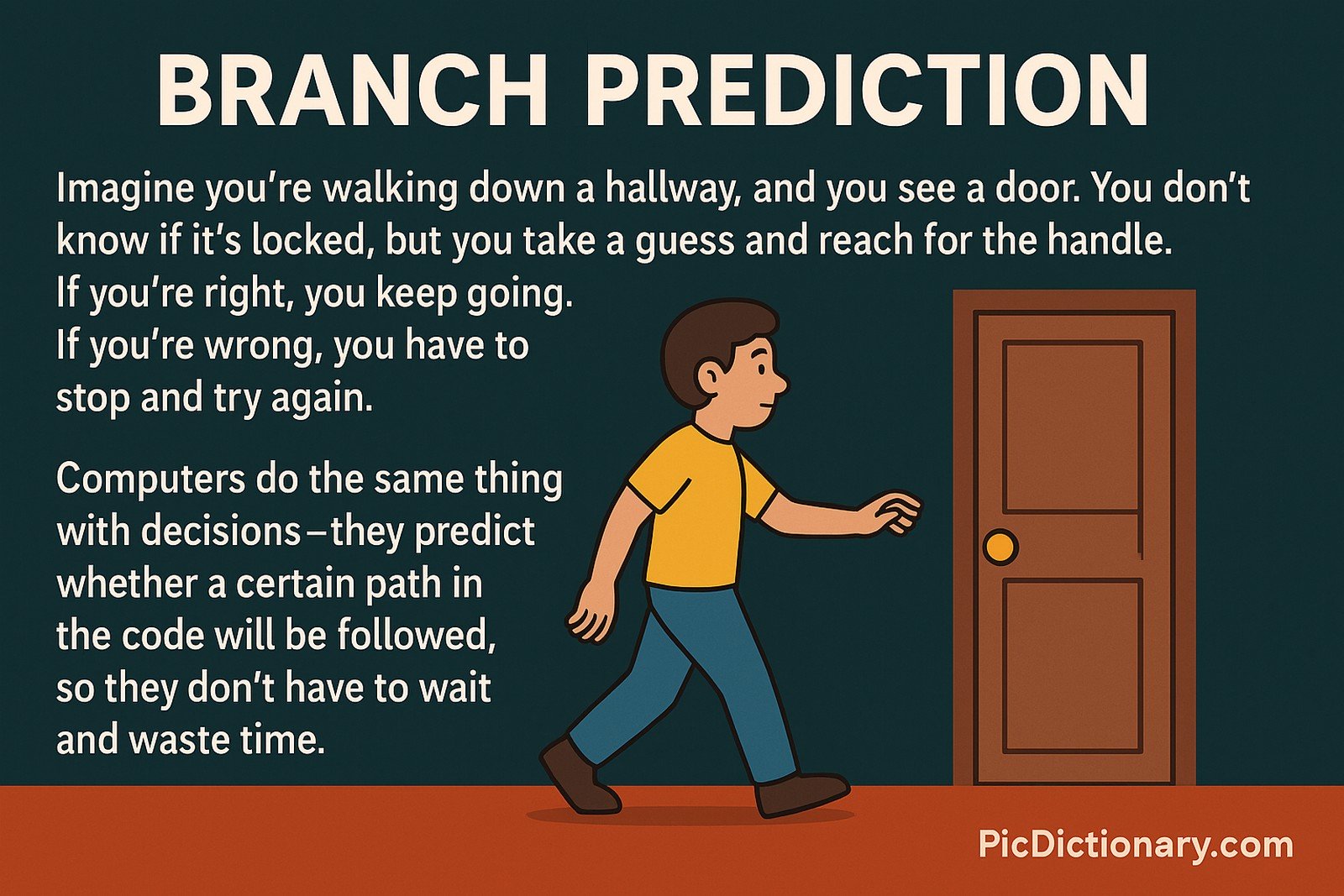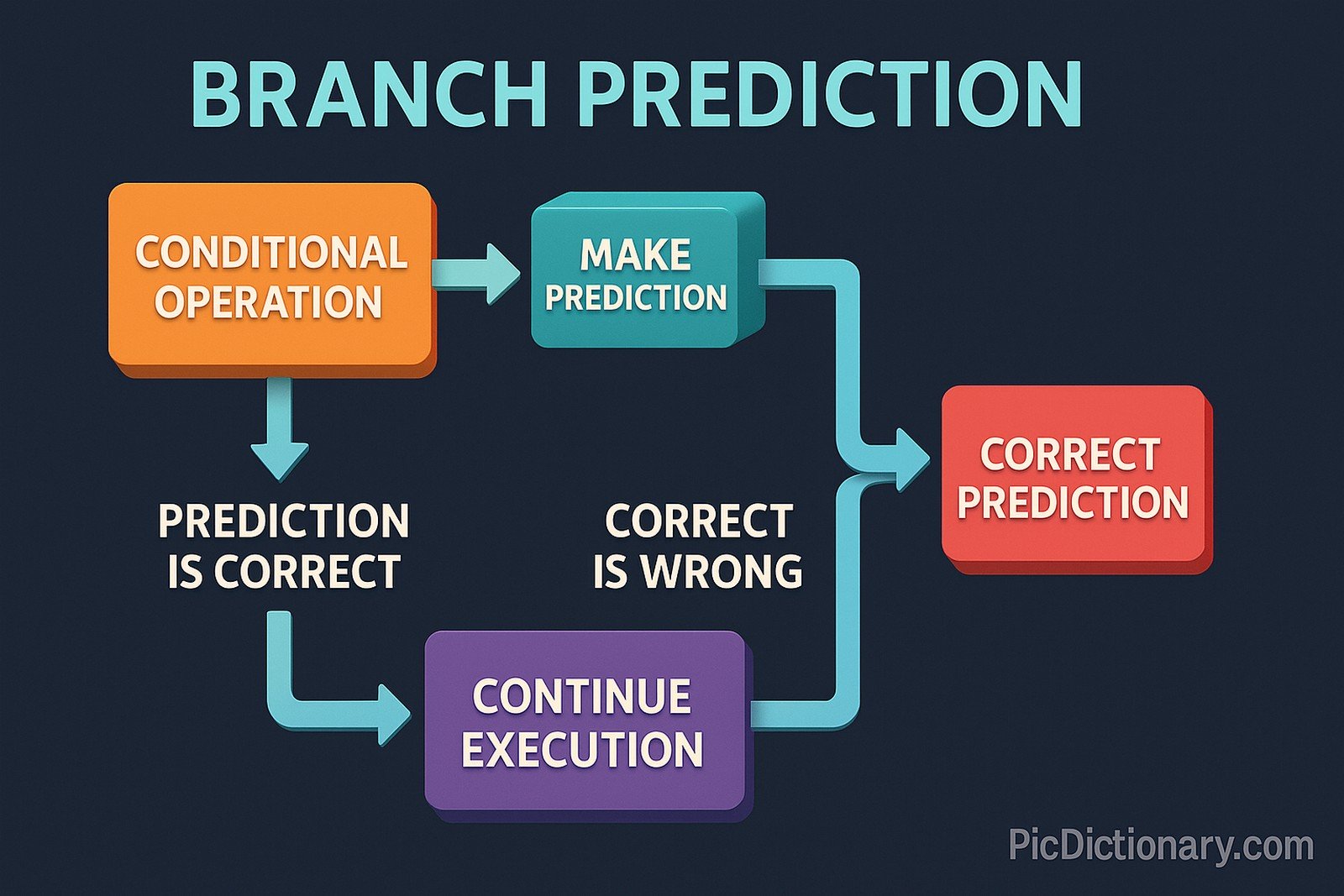Branch Prediction
 (Representational Image | Source: Dall-E)
(Representational Image | Source: Dall-E)
Quick Navigation:
- Branch Prediction Definition
- Branch Prediction Explained Easy
- Branch Prediction Origin
- Branch Prediction Etymology
- Branch Prediction Usage Trends
- Branch Prediction Usage
- Branch Prediction Examples in Context
- Branch Prediction FAQ
- Branch Prediction Related Words
Branch Prediction Definition
Branch prediction is a technique used in computer processors to improve performance by guessing the outcome of conditional operations before they are executed. Modern CPUs rely on branch predictors to anticipate whether a branch (such as an "if" statement) will be taken or not, allowing them to continue executing instructions without waiting. Efficient branch prediction minimizes pipeline stalls and enhances the processor's overall speed.
Branch Prediction Explained Easy
Imagine you’re walking down a hallway, and you see a door. You don’t know if it’s locked, but you take a guess and reach for the handle. If you’re right, you keep going. If you’re wrong, you have to stop and try again. Computers do the same thing with decisions—they predict whether a certain path in the code will be followed, so they don’t have to wait and waste time.
Branch Prediction Origin
The concept of branch prediction emerged in the 1960s with early pipeline processors. As CPU architectures became more advanced, branch prediction techniques evolved to reduce wasted cycles caused by incorrect guesses. By the 1990s, sophisticated dynamic branch prediction methods were widely adopted in processors like those from Intel and AMD.
Branch Prediction Etymology
The term "branch prediction" comes from "branching" in programming, which refers to decision-making points in code. "Prediction" signifies the CPU's attempt to forecast the correct execution path before the actual computation occurs.
Branch Prediction Usage Trends
Branch prediction has grown increasingly important as processors have become more complex. Early CPUs used simple static predictions, but modern processors utilize dynamic branch prediction, leveraging machine learning techniques and neural networks. High-performance computing, gaming, and AI-driven applications benefit significantly from advanced branch predictors, which help optimize execution speed.
Branch Prediction Usage
- Formal/Technical Tagging:
- CPU Architecture
- Instruction Pipelines
- Predictive Execution - Typical Collocations:
- "branch predictor efficiency"
- "misprediction penalty"
- "dynamic branch prediction algorithm"
- "branch target buffer"
Branch Prediction Examples in Context
- Modern gaming processors use branch prediction to improve real-time rendering and reduce lag.
- High-performance servers rely on branch prediction to handle complex computations efficiently.
- AI accelerators incorporate branch prediction to optimize deep learning model execution.
Branch Prediction FAQ
- What is branch prediction in CPUs?
Branch prediction is a technique used in processors to guess the outcome of conditional branches and minimize execution delays. - Why is branch prediction important?
It prevents delays caused by waiting for decisions, allowing CPUs to run faster and more efficiently. - How does branch prediction work?
The processor uses historical data and algorithms to predict whether a branch will be taken or not, executing instructions ahead of time. - What happens if branch prediction is wrong?
If the prediction is incorrect, the processor must discard incorrect computations and restart, leading to a performance penalty. - What are the types of branch prediction?
The two main types are static branch prediction (fixed rules) and dynamic branch prediction (adaptive based on past behavior). - Which CPUs use branch prediction?
Nearly all modern CPUs, including those from Intel, AMD, and ARM, use advanced branch prediction techniques. - How does branch misprediction affect performance?
A misprediction can stall the instruction pipeline, wasting CPU cycles and reducing efficiency. - What is a branch predictor?
A branch predictor is a hardware component in the CPU that estimates the outcome of conditional branches. - How has branch prediction evolved over time?
Early processors used simple methods, but modern CPUs employ complex neural network-based predictors for better accuracy. - Can branch prediction be improved?
Yes, researchers are developing more advanced machine-learning-based predictors to further enhance CPU performance.

Branch Prediction Related Words
- Categories/Topics:
- Computer Architecture
- Pipeline Processing
- Performance Optimization
Did you know?
In 1995, the Pentium Pro was among the first processors to feature advanced dynamic branch prediction, drastically improving performance over previous models. Today, branch prediction techniques are so refined that some CPUs achieve over 95% accuracy in their predictions, significantly boosting speed and efficiency.
PicDictionary.com is an online dictionary in pictures. If you have questions or suggestions, please reach out to us on WhatsApp or Twitter.Authors | Arjun Vishnu | @ArjunAndVishnu

I am Vishnu. I like AI, Linux, Single Board Computers, and Cloud Computing. I create the web & video content, and I also write for popular websites.
My younger brother, Arjun handles image & video editing. Together, we run a YouTube Channel that's focused on reviewing gadgets and explaining technology.



Comments powered by CComment